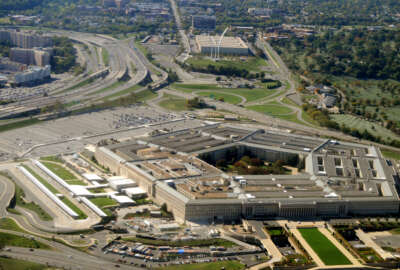
DoD in process of splitting responsibilities for two new acquisition offices
The Defense Department is starting its preliminary work to cut its acquisition office in half, including assigning distinct responsibilities to each new office.
The Defense Department is parsing out exactly how it will split one of its biggest and most infamous sections after Congress mandated the division last year.
The Pentagon is doing preliminary work on splicing its acquisition office into two distinct areas: research and engineering, and day-to-day business acquisitions, said Mary Miller, acting assistant defense secretary for research and engineering during an April 18 speech at a National Defense Industrial Association event in Washington.
Part of that work includes assigning distinct responsibilities to each new office. DoD is now picking out actions that were once housed under one roof to be passed off to their new acquisition office parents.
“We wanted to create two undersecretaries [for acquisition]. One, the undersecretary for research and engineering that is really focused on maintaining technology superiority across the globe. It is risk taking, it will do prototyping, it will do experimentation. It will allow and challenge the Defense Department each and every step along the way to think differently, to think large, to think future,” Miller said. “And then there was the undersecretary of acquisition and sustainment, which will focus on affordability, efficiencies, getting things to the warfighter faster and making sure it is the right things.”
Miller said DoD split office responsibilities along those roles.
The research and engineering side will work on prototyping, experimentation, tech transition, tech development, allocation of resources of research and unifying research efforts.
On the other hand, DoD has assigned roles like acquisition policy design, procurement of goods and services, sustainment policy, logistics, maintenance, industrial base policy, contract administration, nuclear modernization and counter weapons of mass destruction to the acquisition and sustainment side of the house.
Miller said there will be a natural tension between the two offices. One is about creating risk, while the other is about mitigating it.
“It’s a great strategy, but it’s exceptionally challenging to implement,” Miller said.
The challenge goes beyond simply reorganizing the offices, it deals with changing the culture within the new offices as well.
“The workforce is uncomfortable. They don’t know what it means and we haven’t been able to tell them much because the secretary is still kind of saying ‘Do I like this plan? Do I not like this plan? What do I really want to do?’” Miller said.
Under the new strategy the two offices need to develop long-term disruptive advantages, as well as create operational capabilities.
Latest Defense News
DoD is expecting the offices to invent new technologies and processes and engage with allies and partners, all while remaining cost effective.
DoD is mandated by Congress to create the offices by February 2018 and must deliver its implementation plan by August 2017.
Miller said DoD is trying to actually make change and not just move around its organization chart as it tries to create the new offices.
Right now there is a small cross functional team working on the two offices and how they fit in with the chief management office.
Not everyone is a fan of the congressional reforms, however. Frank Kendall, the former undersecretary of Defense for acquisition, technology and logistics, hammered the congressional mandate in his last speech.
“The right model is to have one person who’s responsible for the total lifecycle of our programs. I’m not sure how this is going to work out, and I don’t think it’s a good thing,” Kendall said in January. “One of the things we’ve worked very hard on over the last few years is to have my assistant secretary for acquisition and my assistant secretary for research and engineering work very closely together and focus on the transition of technology into products. If we separate products from research, that’s going to be harder because it’s at a higher level in the bureaucracy now.”
Copyright © 2025 Federal News Network. All rights reserved. This website is not intended for users located within the European Economic Area.
Scott Maucione is a defense reporter for Federal News Network and reports on human capital, workforce and the Defense Department at-large.
Follow @smaucioneWFED





